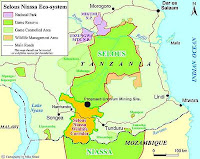The United States National Marine Fisheries Service has declared the Tanzanian population of the African Coelacanth, Latimeria chalumnae, to be officially Threatened under the terms of the Endangered Species Act, in a ruling that was published on 29 March this year and became law on 28 April. This judgement will not result in the creation of a protected area, as the entire range of the species is outside of US jurisdiction, nor in the implementation of any new trade regulations, as the species is already listed under the terms of the Convention on International Trade in Endangered Species of Wild Flora and Fauna and trade in the species is unknown beyond a small number of scientific specimens. However it is hoped that this ruling will help to raise awareness of the current plight of the species, and the ruling will allow potential US funding of conservation projects targeting the species.
An African Coelacanth, at Sodwana Bay, South Africa. Laurent Ballesta/Blancpain Ocean Commitment.
The ruling was made in response to a request by the conservation organisation WildEarth Guardians made in July 2013, and was the subject of a series of assessments before the ruling could be made.
Firstly it was necessary to establish that the Coelocanth was a distinct species or subspecies, and therefore eligible for protection under the terms of the Endangered Species Act. This can be problematic for some organisms, however there are only two species of surviving species of Coelacanth, (the African Coelacanth and the Indonesian Coelacanth, Latimeria menadoensis), a group considered to be highly important by scientists studying the origin of terrestrial vertebrates, and as such the group have been extensively studied and there is no doubt over the status of the two species.
Secondly it was necessary to establish that the group is Endangered or Threatened throughout all or part of its range. The term Endangered implies at current risk of extinction, while Threatened implies at danger of extinction in the foreseeable future, a harder criteria to define. The African Coelacanth could not be classed as at risk throughout its range, as current conservation measures in the Comoros are believed to be highly effective, however the Tanzanian population does not currently receive any such protection, and is currently deemed to be at risk from drift-netting, a fishing technique that does not directly target the species, but which can result in Coelocanths being caught as by-catch, and is considered to be at risk due to the proposed construction of a deep water port at Mwambani Bay in the Tanga Region of the country, a project which is centred on the site of a proposed marine park intended to protect the species, and which has already resulted in local communities being evicted from the area ahead of any Environmental Impact Assessment, leading to concerns that any such assessment may either not be carried out or will simply be a rubber-stamp exercise intended to give legitimacy to the project.
See also...
 African Barrick Gold sued over deaths at Tanzanian mine. The mining company African Barrick Gold, a subsidiary of the Canadian Barrick Gold Corp, is being sued by representatives of 12 Tanzanian villagers over a...
African Barrick Gold sued over deaths at Tanzanian mine. The mining company African Barrick Gold, a subsidiary of the Canadian Barrick Gold Corp, is being sued by representatives of 12 Tanzanian villagers over a... Pregnant woman killed in rioting over Tanzania gas pipeline. A pregnant woman was reportedly shot and killed by security forces
during rioting in the southern Tanzanian city of Mtwara on Thursday 23
May 2013, that led to...
Pregnant woman killed in rioting over Tanzania gas pipeline. A pregnant woman was reportedly shot and killed by security forces
during rioting in the southern Tanzanian city of Mtwara on Thursday 23
May 2013, that led to... Uranium mining to begin in Tanzania. A uranium mining project at Mkuju River has been granted a license by the Tanzanian Ministry of Energy and Mineral Resources,
despite widespread opposition within the country. The license has been
granted to Mantra Tanzania, a subsidiary of the Australian Mantra Resources, which is itself owned...
Uranium mining to begin in Tanzania. A uranium mining project at Mkuju River has been granted a license by the Tanzanian Ministry of Energy and Mineral Resources,
despite widespread opposition within the country. The license has been
granted to Mantra Tanzania, a subsidiary of the Australian Mantra Resources, which is itself owned...
Follow Sciency Thoughts on Facebook.
Environmental Impact Assessment
Mwambani Bay
Mwambani Bay in Tanga Region
Mwambani Bay in Tanga Region
Mwambani Bay in Tanga Region
Mwambani Bay in Tanga Region
Mwambani Bay in Tanga Region
Mwambani Bay in Tanga Region
Mwambani Bay in Tanga Region

